Advanced scripting (print scripting)
PaperCut's advanced scripting interface is a powerful and flexible feature that you can use to define and fine tune your printing policy. While there are many features that you can enable by selecting check boxes and changing options in the Admin web interface, scripting your own behavior introduces a whole new level of customization.
The functionality made possible by scripting is varied and is constantly being extended based on customer demand. Some common uses include:
-
Displaying a popup message if a user forgets to select duplex on large jobs.
-
Showing a dialog that displays environmental impact statistics about a user's print job such as the amount of carbon dioxide equivalent greenhouse gases produced.
-
Prompting the user to confirm large jobs before printing.
-
Automatically routing large jobs to more efficient high volume printers.
All of the above is possible by writing a small script directly into a code editor in the Admin web interface. In fact, the above functionality is a pre-built recipe ready to use.
Other usage examples include:
-
Requesting job data/security classification.
-
Giving discounts during off-peak times.
-
Charging printing to departments during class-time.
-
Displaying warning messages under selected conditions.
-
and many, many more.
At a high level, advanced scripting provides the ability to:
-
Adapt logic based on print job attributes such as cost, pages, document name, time, etc.
-
Modify job attributes and behavior such as routing the job to another printer, influencing job cost and account charged, and appending metadata such as comments.
-
Interact with end users via client messages and popups/dialog boxes.
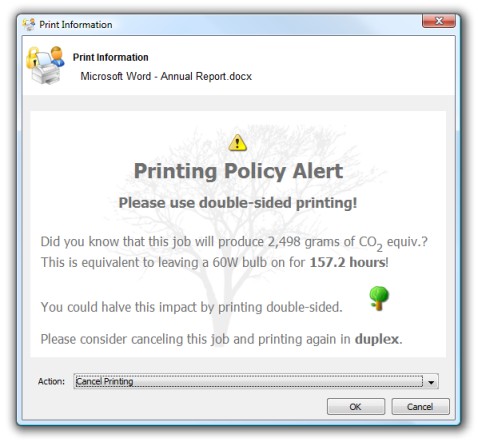
Prerequisites
Writing print scripts brings many possibilities but also introduces the possibility that writing a buggy print script results in unexpected behavior. Previous experience with scripting or programming is strongly recommended. PaperCut MF does provide a number of tools to assist with script development, however, including:
-
A mini JavaScript editor with basic error checking and syntax highlighting.
-
Quick access to a code cookbook containing dozens of best-practice recipes.
-
Pre-canned "code snippets" demonstrating the use of key functions.
-
Simple debugging tools such as logging and runtime error reporting.
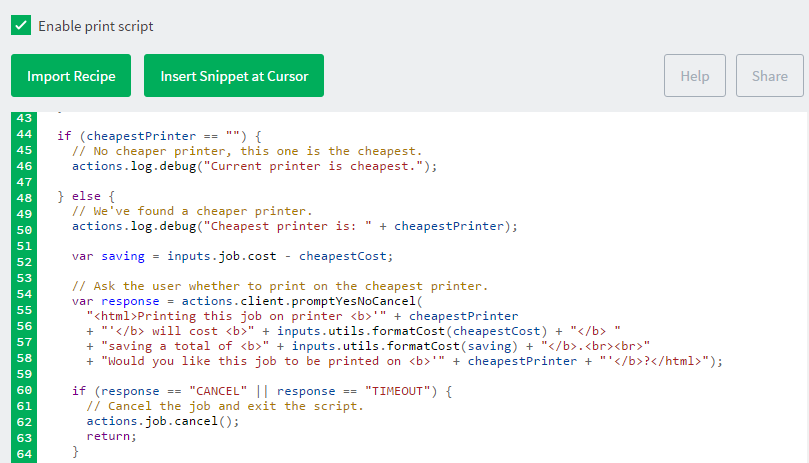
All of PaperCut MF's advanced scripts are written using the world's most popular scripting language, JavaScript (also known as ECMA-262 ECMAScript... apparently ;).
Why JavaScript? JavaScript was selected as PaperCut MF's scripting language after careful consultation with the existing user base. JavaScript was the language common to SysAdmins across all platforms (Windows, Mac and Linux). Its popularity in HTML programming also meant most administrators already had extensive exposure to the language. Internally PaperCut uses the Rhino scripting engine maintained by Mozilla.org, makers of the popular Firefox browser. It is highly performant and allows PaperCut MF to leverage advanced scripting without compromising system scalability. This is done using advanced techniques such as just-in-time compilation.
Create a print script
Print scripts are segments of code that are run whenever a new print job arrives in the queue. The script is defined using the concept of a "hook". A hook is a JavaScript function (e.g. function printJobHook(inputs, actions) { }) that is called for each new job. Your print script defines this method, its behavior, and its actions.
All scripts are defined on a per printer basis allowing each printer to have its own logic (although you can share/copy a common script between printers
To create a print script:
-
Click the Printers tab.
The Printer List page is displayed.
-
Select a printer.
The Printer Details - Summary page is displayed.
-
Click the Scripting tab.
-
Select the Enable print script checkbox.
-
Create your script in one of the following ways:
- import a predefined recipe (script)
- write your own script using snippets
-
Click Apply.
One good way to experiment with print scripting is to apply your script initially on a test printer (or fake print queueA print queue displays information about documents that are waiting to be printed, such as the printing status, document owner, and number of pages to print. You can use the print queue to view, pause, resume, restart, and cancel print jobs., such as a print queue pointing to an unused LPT port). This allows you to test and experiment, and when the logic is right, copy/deploy across to other live printers.
Recipes
Recipes demonstrate best practice and should be considered as a starting point for development of your own scripts.
To use a recipe:
-
Click Import Recipe.
A list of the predefined recipes is displayed. For example, the Print Policy Enforcement (warnings & automatic conversion) recipe:
- discourages single-sided printing
-
discourages printing of emails in color
-
discourages printing of web pages in color
-
discourages printing of emails that have more than one page
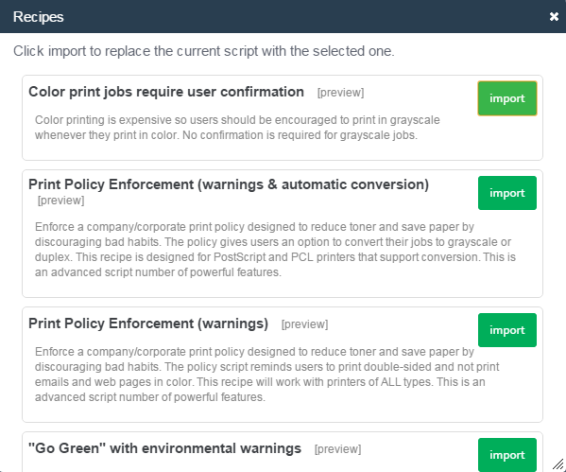
-
Click Import next to the recipe you want to use.
A confirmation prompt is displayed.
-
Click OK.
-
Click Apply.
The recipe replaces what is currently in your script.
Snippets
Code snippets are small code fragments that demonstrate how to use the scripting APIApplication Programming Interface (API) is a set of routines, protocols, and tools for building software and applications. An API expresses a software component in terms of its operations, inputs, outputs, and underlying types, defining functionalities that are independent of their respective implementations, which allows definitions and implementations to vary without compromising the interface. (inputs, functions, and methods). Consider using snippets as a base for adding functionality to your script.
To use a snippet:
- Place your cursor in the position you want to insert the snippet.
-
Click Insert Snippet at Cursor.
A list of code snippets is displayed. For example, the Test if job is color snippet provides the code to check if a print job is being printed in color. This could be used as part of a script to perform an action on all color print jobs.
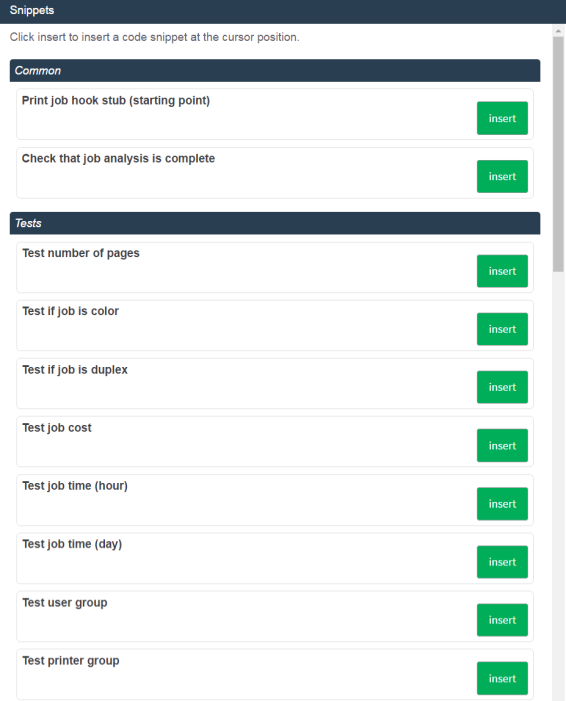
-
Click insert next to the snippet you want to use.
A confirmation prompt is displayed.
-
Click OK.
- If required, you can modify the code to suit your needs.
-
Click Apply.
The snippet is added to your script.
Error messages
Error messages are classed into two groups:
-
Syntax errors—these are detected and displayed when a script is applied. The script does not save until all syntax errors are addressed.
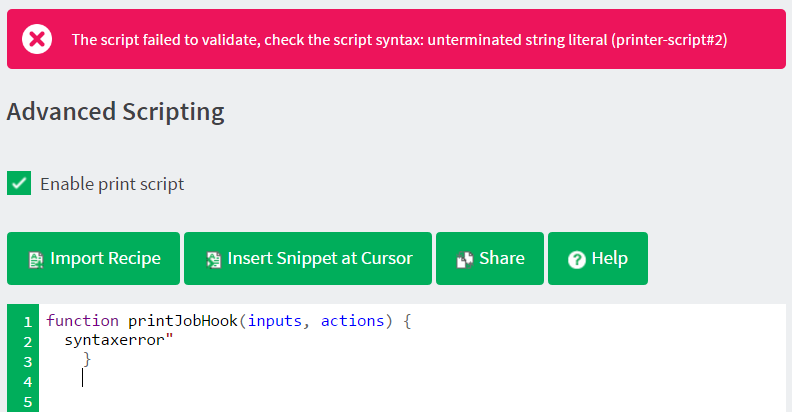
-
Runtime errors—these are errors that only occur when a script is executed for a print job. Runtime errors are also listed on the Scripting tab in red. Refresh the page to see runtime errors. Runtime errors are also logged and are displayed on the App Log tab.
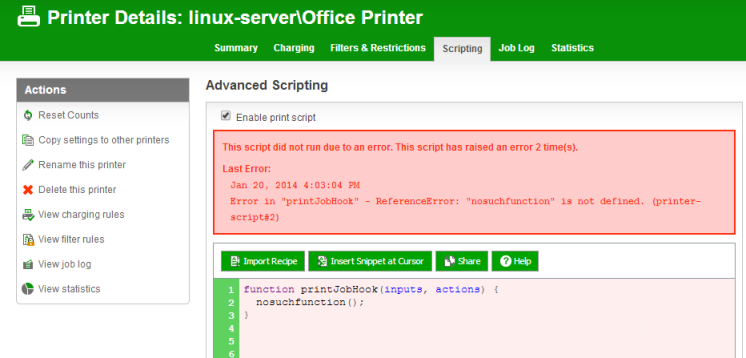
Where possible the error message indicates the line number on which the error was found and the relevant line is highlighted.
Advanced print scripting - global include script
Large organizations with advanced print scripting requirements might need to share common code between different print scripts. Use advanced scripting techniques to build these common libraries.
Writing a common script allows reuse of JavaScript code and functions without needing to copy script code to all printers. Write the common script code in a file named print-script-common.js and save it in the [install-path]/server/custom directory. This script is included and executed automatically and functions created in this file are accessible from all print scripts.
Errors in the common print script are detected and displayed in the Scripting page. The error message contains the name of the common script file, the error, and the line number where the error occurred. Refresh the page to see these errors. These errors are also displayed on the App. Log page.
Tips for print scripts
-
Use snippets and/or recipes where possible. They are tested and demonstrate best practice.
-
Start out small and aim high. Don't try building your script all in one go. Write a bit, test, then move on. Large scripts written in one go are hard to debug.
-
Always test your scripts! Just because a script compiles does not mean it is bug free. Take time to test your script and exercise all logic paths. For example, if your script applies an action to jobs with more than 100 pages, test it by printing jobs that are both more and less than 100 pages.
-
Check all your scripts from time to time for runtime errors and/or enable error level event notifications to receive an email when errors occur (see Error level event notifications).
-
Take some time to explore the list of methods in the reference API documentation (see Print script API reference). Knowing what is possible can open up ideas.
-
Use actions.log.debug() or actions.client.sendMessage() to assist with "print line" style debugging.
-
If your scripts interact with end users, perform some usability testing to ensure they understand your messages and intentions.
-
Consider using HTML markup to pretty up your dialog messages (see the snippet titled Show a dialog with HTML formatting).
